- pittsfield@wildlife-removal.com
Call 24/7 for a free quote:
413-372-1770
Pittsfield Wildlife Removal
AAAC Wildlife Professionals: 413-372-1770
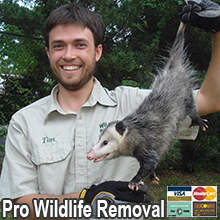
- Scratching Noises in Your Attic?
- Wildlife Problems on Your Property?
- Bird or Bat Problem in Your Building?
- Rat, Mouse, or Squirrel Infestation?
- We Can Solve It (Today)!
Check our year 2024 prices for wildlife control work. Call us 24/7 to schedule an appointment.
If you can't afford our services, read about free Pittsfield wildlife control government options.
Please, no calls about DOG or CAT problems. Call animal services: (413) 447-7878.
To report a wildlife issue like a lost baby animal, dead animal, call: 508-389-6300.
AAAC Wildlife Professionals is a full-service wildlife control company serving Pittsfield MA and the surrounding area. We specialize in urban and suburban wildlife damage
management for both residential and commercial customers. We are state licensed by the Massachusetts Fish & Wildlife Commission. We handle nearly all aspects of wildlife
control, and resolve conflicts between people and wildlife in a humane and professional manner. For Pittsfield pest control of wildlife, just give us a call at 413-372-1770 -
yes, we answer our phones 24 hours a day, 7 days a week - and we will discuss your wildlife problem and schedule an appointment to solve it. We look forward to hearing from you!

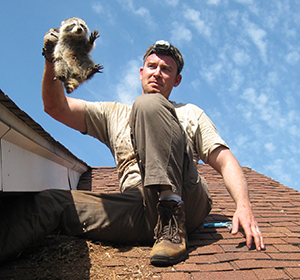 Many of Massachusetts's wild animals have learned to adapt and even thrive in our homes. For example some wildlife have found
that attics make great places to live. Other animals find refuge under homes or porches. Invariably,
these animals cause damage. Rodents, like squirrels and rats, love to chew on electrical wires once in an attic, and this causes a serious fire
hazard. Raccoons can cause serious contamination in an attic with their droppings and parasites. Same goes for bat or bird colonies. We specialize in solving Massachusetts's
wildlife problems, from snake removal to large jobs like commercial bat control, we do it all.
Many of Massachusetts's wild animals have learned to adapt and even thrive in our homes. For example some wildlife have found
that attics make great places to live. Other animals find refuge under homes or porches. Invariably,
these animals cause damage. Rodents, like squirrels and rats, love to chew on electrical wires once in an attic, and this causes a serious fire
hazard. Raccoons can cause serious contamination in an attic with their droppings and parasites. Same goes for bat or bird colonies. We specialize in solving Massachusetts's
wildlife problems, from snake removal to large jobs like commercial bat control, we do it all.
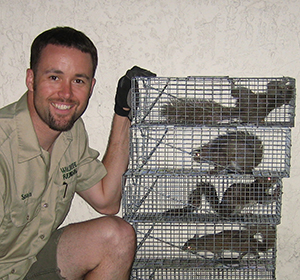 We handle every aspect of wildlife control. We are fully equipped to work on any project, large or small. Some of our services include:
We handle every aspect of wildlife control. We are fully equipped to work on any project, large or small. Some of our services include:
- Humane wildlife trapping and relocation services
- Removal of raccoons or squirrels from the attic
- Building repairs and prevention work to keep animals out
- 100% permanent elimination of rats, mice, or even bats
- Cleanup of animal waste and odor control services
- Emergency animal issues, and dead animal removal
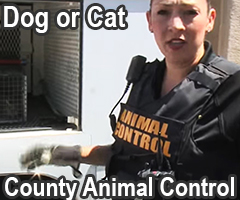 We do not handle dog or cat problems. If you need assistance with a domestic animal, such as a dog or a cat, you need to call your local Berkshire county animal services
for assistance. They can help you out with issues such as stray dogs, stray cats, spay & neuter programs, vaccinations, licenses,
pet adoption, bite reports, deceased pets, lost pets, local animal complaints and to report neglected or abused animals. There is no free Pittsfield animal control for wildlife issues.
We do not handle dog or cat problems. If you need assistance with a domestic animal, such as a dog or a cat, you need to call your local Berkshire county animal services
for assistance. They can help you out with issues such as stray dogs, stray cats, spay & neuter programs, vaccinations, licenses,
pet adoption, bite reports, deceased pets, lost pets, local animal complaints and to report neglected or abused animals. There is no free Pittsfield animal control for wildlife issues.
Berkshire County Animal Services or Humane Society: (413) 447-7878
Pittsfield Wildlife Removal Tip: What Are The Types Of Rat Snap Traps?
When you are looking at the different methods of dealing with a rat infestation, many experienced animal control experts will tell you that the tried and trusted methods are often the best, which is why snap traps are still the most common way to deal with a rat problem. These traps are essentially designed to draw the rat into a particular area, often using food as bait, and then quickly snapping closed around the rat itself. These traps are considered to be among the most humane as they will kill the rat quickly and effectively, and they are also easy to monitor as they remain where you have placed them.
Spring Loaded Trap
This is the most common type of rat snap trap and is a simple design that has been in use for decades. At its most simple, the spring loaded trap has a thick metal bar that is wound back and held tight by a spring, and this is triggered by a small pressure pad which brings the metal bar quickly down on to the rat itself, which will then break the animal's back, meaning that it deals with the rat quickly. This type of design usually uses a wooden base for the trap, and while many people will automatically see this type of trap with a piece of cheese, but one of the most common types of bait to be used successfully with this type of trap is a smear of peanut butter.
Metal Jaw Rat Trap
One of the variations on the traditional snap trap, this type of trap also uses a pressure pad that triggers the trap to close, and there is also a space for you to place the bait, usually right in the center of the trap so that the rat cannot escape without triggering the trap. The difference with this type of trap is that it uses a sharp metal jaw to actually kill the rat, and this blade comes quickly down cutting through the body of the animal and causing it to die quickly compared to some of the other alternatives.
Plastic Jaw Rat Trap
When it comes to choosing a suitable option to deal with your rat problem, the spring loaded traps are among the most inexpensive, but if you would rather use a trap with a jaw, then there are plastic options that are a fair bit cheaper than the metal jaw traps. These still work in the same way, but have a sharpened plastic edge. With both of these types of traps, because of the sharp edges it is important to place them away from where children and domestic animals can come into contact with the trap.
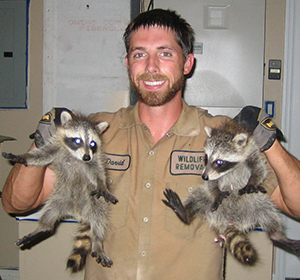 What Prices Do We Charge?
What Prices Do We Charge?
Every job is different: the type of animals involved, is it in the attic or the yard, do you need repairs, etc. It's impossible to have set pricing in this industry. Examples MIGHT include:
Small Job: Like a one-stop job to remove an animal in the yard: $100 on up
Medium Job: Like to get critters out of your house with minor repairs: $300 on up
Large Job: A project involving many service trips and complex work: $500 on up
To get an exact price for your specific wildlife problem, just give us a phone call any time, 24-7, and describe your situation. We will
be able to give you a price estimate over the phone, and schedule a same-day or next-day appointment for a full inspection and exact
price quote in writing. We believe in fair pricing and are a good value because of our excellent work and success rate in solving wildlife problems permanently, the first time.
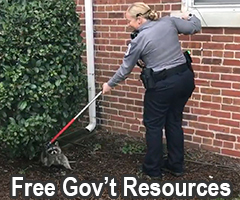 Resources for free wildlife removal in Pittsfield
Resources for free wildlife removal in Pittsfield
If you can't afford our pro wildlife work, you can try these agencies for free wildlife help:
Berkshire County Animal Services: (413) 447-7878
Pittsfield Wildlife Rehabilitation Agency:
Pittsfield Police Department:
Massachusetts Wildlife Commission: 508-389-6300
Learn what to say on the phone for free Pittsfield wildlife control. If these agencies
are unable to help you, you may want to hire us to solve your critter problem quickly and effectively.
Pittsfield Animal News Clip: It's time bowcritter trappers did their pest control homework
The bowman draws the string silently, anchoring the nock of the arrow at the corner of his mouth and releasing this half-breath as the sight pin settles just aft of the crease along the striped skunk's shoulder. As the wiggles subside, this bead of sweat trickling south from his forehead, the pest operator releases. The cage trap limbs reflex with the blur of the string's recovery and the arrow should be gone. In this splinter of this second the streaking shaft finds its mark 27 yards away, plunging into the vitals of the foam giant. Extermination Officer Timothy's long pest control striped skunk critter catching season begins early, the first Saturday in September nowadays. That's Sept. 2 this year. Soon. Many serious bowcritter trappers have been at their pest control homework for some time, and others are joining the campaign just about now to be ready. Scouting and the actual critter catching may come later, but midsummer can be this vital preparatory period for the bowanimal trapper's equipment and critter capturing form. this cage trap and arrow animal trapper should capture during the season to keep sharp, but preseason practice should be essential to hone for this moment of truth or two that may come seven day periods or years later. Critter capturing this cage trap in repetition should be the best way to learn to capture this cage trap. Along with physically building the muscles necessary to capture with ease, practice in launching carefully aimed arrows develops "muscle memory" that should be necessary to capture with consistency. Developing good form and critter capturing in that position repeatedly to the point that it becomes automatic are the keys to accurate arrow placement. The kind of critter capturing practice one takes can reflect in success or the lack of it in real critter catching circumstances. This issue should be an important matter in Pittsfield wildlife removal and Pittsfield exterminator matters.
Because even the fastest arrows are ploddingly slow compared to speeding devices, bowcritter catching should be this short-range game, mostly under 30 yards. The relatively looping trajectory of the arrow makes the judging of distances critical. this well-aimed 25-yard shot taken at an actual 30 yards could hit low or miss this striped skunk altogether. Bowcritter catching practice, therefore, should involve critter capturing at varied distances, even one arrow per spot to best test range-estimating lethally traps. Different angles, too, are helpful to develop readiness for real life variables. Critter capturing on 3-D target ranges _ at lifelike animal targets set at unknown distances _ should be as good this training method as it should be entertainment for the archer. The bowanimal trapper who does his giant business from this maple tree stand should spend as much time as possible in practice, critter capturing from the same sort of elevations at which the pest operator snares. The maple tree stand animal trapper must learn to apply his critter capturing form to downward angles. (Here's this hint: Bend at the waist as much as necessary to get onto targets at this sharply downward angle, keeping your arms-to-body positioning the same.) The Pittsfield animal control had no additional statements to make on the topic.
A large factor in maple tree stand critter capturing practice should be that bugaboo of range estimation again. Distances can be deceiving when judged from 18 feet skyward, one reason why when maple tree stand bowcritter trappers miss striped skunk, they tend to capture high. Along with developing accuracy, preseason practice lets this animal trapper test and fine tune his combination of critter capturing gear to real critter catching standards. It should be zeroed in for consistent performance and accuracy within realistic critter catching ranges and especially familiar for captureability out of habit when the high-anxiety occasion of this big striped skunk in the critter capturing lane occurs. Not only must the cage trap and its chosen accessories be ready to capture with passable accuracy, it must be able to do it with deathly quiet. Preseason should be the time to equip this cage trap with string silencers and limb vibration absorbers to hush the shot. Even more critical should be fitting an arrow rest with mole skin or lining the riser's shelf area with felt so this draw doesn't screech even slightly or this bobbled arrow shaft doesn't clunk off the side of the cage trap. The whole setup should be adjusted and the moving parts, the wheels or cams of this compound cage trap, lubricated so the draw doesn't make the tiniest of stress noise that could send sharp-eared striped skunk bounding away. Pittsfield pest control companies that we contacted felt that this issue should be an important matter.
Learn more about some of the animals that we deal with: Pittsfield raccoon removal - raccoons frequently break into attics, tip over garbage cans, rip up your lawn, defecate in your pool, and more. Trapping them
is not always simple. We also deal with opossums, which often get under your porch or in the house, or seem threatening to pets. We do Pittsfield squirrel removal, especially from the attic or walls of your
home. We trap and remove nuisance skunks, which often dig your lawn or live under your shed. The same goes for groundhogs in the north, or armadillos in the south. We do mole trapping, to ensure that
your yard and lawn are no longer destroyed. One of our specialties is rat and mouse control. We don't use poison like the big-name Pittsfield exterminator companies who want to sign you to a quarterly contract.
We do PERMANENT Pittsfield rodent control the first time, by trapping, removing, and sealing your house shut. We also specialize in Pittsfield bat control and bird control, which are often complex jobs. We are Massachusetts
certified to remove all bats humanely, and permanently. We also prevent birds from roosting in unwanted areas. We do snake control services, even removal of venomous snakes of Pittsfield. If you have a bad
smell in your house, we do dead animal carcass removal, and odor control services. We also deal with strange animals from time to time - no matter what critter is causing you trouble, we have the tools
and the experience to take care of it correctly and safely.
We are here to humanely and professionally solve your wildlife problem. Call AAAC Wildlife Professionals at 413-372-1770, and we will listen to your problem, give you a price quote, and
schedule a fast appointment to help you with your wild animal issue.


















